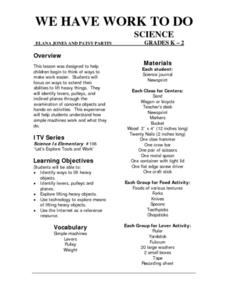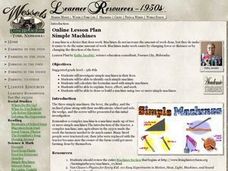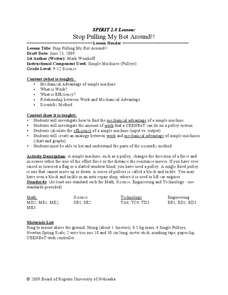Curated OER
We Have Work to Do!
An excellent lesson awaits your young scientists! In it, learners are invited to explore the world of pulleys, levers, and planes; simple machines that make lifting heavy things much, much easier. They watch video, and engage in hands-on...
Curated OER
Welcome to the Wonderful World of Machines
Designed for a lower elementary school classroom, this presentation on simple machines is a wonderful way to introduce this topic. The resource begins by identifying and defining the six types of simple machines, and then goes on to...
Curated OER
Simple Machines IV - Levers
The lever is an everyday simple machine. Youngsters learn the principles of levers and explore their many uses. Groups of pupils perform a simple lab where they lift objects with a fulcrum while placing the load in a variety of...
Curated OER
Simple Machines
Here is an inventive plan that should get your young scientists excited! In it, groups of pupils test out the work done by six different simple machines. The machines are: the wedge, the lever, the inclined plane, the pulley, the screw,...
Curated OER
Simple Machines III - Pulleys
The principles behind pulleys, levers, and simple machines are the focus of a science instructional activity. In it, learners take part in a whole-class activity. There are two groups of pupils who each must lift objects with fixed...
Curated OER
Levers and Pulleys
Seventeen pages of material leave you well-prepared to carry out this lesson on levers and pulleys. Photos and diagrams make the instructions clear; resource links provide additional information. The missing aspects of this teacher's...
Curated OER
Pulleys
In this simple machines instructional activity, students learn about pulleys. They then answer the 11 questions on the page. The answers are on the last page of the packet.
Curated OER
Simple Machines: Pulleys
Young scholars observe and analyze how pulleys work and how a double pulley can make work easier. In small groups they use a fixed pulley system and a double pulley system and draw a picture of how their pulley system functions. ...
Curated OER
A Simple Block and Tackle Pulley Demonstration
Students investigate the scientific concept of mechanical advantage. They construct their own system with the use of a simple broomstick. Then the demonstration is done to show how the mechanical advantage is used to move a load.
Curated OER
Pulleys and Gears
Students analyze an engineering problem. They contrast paper and pencil mastery of concepts with hands-on mastery. They present their design and rationale behind it, whether it works or not.
Curated OER
Farming in the 1930's
Students research and conduct experiments with several types of simple machines. They examine levers, pulleys, inclined planes, wheels, axles, wedges and screws and then consider the physics behind "Green Eggs and Ham".
Curated OER
Pulleys
Young scholars determine how to tell the difference between a simple system and a complex pulley system. Using pulleys, students build simple pulley systems to demonstrate the mechanical advantages of pulleys.
Curated OER
Stop Pulling My Bot Around!
Students investigate the relationship between work and mechanical advantage. In this physics lesson, students calculate the work and efficiency of pulleys. They identify the different types of pulleys.
Curated OER
Robotic Muscles
Young scholars investigate how adding more pulleys affect the pulling power. For this physics lesson, students explain how pulleys work. They compare the work done by robots with and without pulleys.
Curated OER
Machinery In Society
Learners explore technology by completing a worksheet in class. In this common machinery instructional activity, students define the different designs that make simple machines work such as wheels, pulleys and gears. Learners utilize...
Curated OER
Pulleys 1
In this simple machines scientific investigation activity, students follow the provided procedures to examine how pulleys work and then respond to 2 short answer questions.
Curated OER
Simple Machines-Pulleys
Third graders understand what a pulley is and how it works. In this simple machines, pulley lesson plan students experiment with broom sticks creating a pulley. Students observe how the pulley moves in its different trials.
Curated OER
Simply Machines
In this machines learning exercise, students draw a "Rube Goldberg" style machine which uses 3 different types of simple machines to complete one task.
Curated OER
Pull(ey)ing The Science Out (Or Pulleys)
Students investigate how the number of pulleys affect the difficulty or ease of pulling an object up. They watch a demonstration that shows the work done by one pulley and two pulleys. After watching the demonstration, the students break...
Curated OER
Simple Machines III - Pulleys
Fourth graders are introduced to a spring scale to show that the forces on both sides of the pulley are the same. They break into groups to lift objects with fixed pulleys and with multiple looped pulleys and then measure the force...
Curated OER
Pulley Power
Third graders engage in a manipulative experiment in the mechanical advantage of simple machines. It graphically demonstrates the change in magnitude of applied force when using simple machines. Great for ESL to discover the ratio...
Curated OER
How Do Simple Machines Work?
In this simple machines worksheet, students brainstorm problems that can be solved by the work of simple machines. This worksheet is a graphic organizer.
Curated OER
Building A Sturdy Car
Learners build a sturdy Lego car using a motor and a pulley. They determine how sturdy the car is by dropping it from the height of the teacher's knee.
























